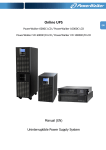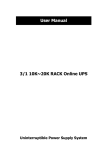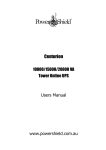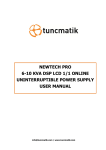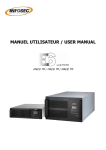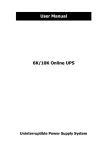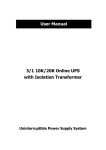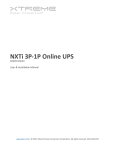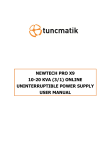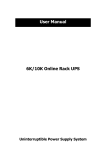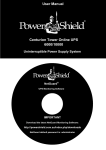Download USER'S MANUAL 3 phase 220V
Transcript
USER’S MANUAL KNIGHT ONLINE SERIES UPS 3 phase 220V KO-100003P1(L) / KO-150003P1(L) / KO-200003P1(L) / KO-100003P1R(L) / KO-150003P1R(L) / KO-200003P1R(L) Uninterruptible Power Supply System Contents 1. SAFETY AND EMC INSTRUCTIONS .................................................................................1 1-1. TRANSPORTATION ............................................................................................................1 1-2. PREPARATION ..................................................................................................................1 1-3. INSTALLATION ..................................................................................................................1 1-4. OPERATION .....................................................................................................................2 2. INSTALLATION AND SETUP .............................................................................................3 2-1. UNPACKING AND INSPECTION ............................................................................................3 2-2. REAR PANEL VIEW ...........................................................................................................3 2-3. SINGLE UPS INSTALLATION ..............................................................................................6 2-4. UPS INSTALLATION FOR PARALLEL SYSTEM .......................................................................9 3. OPERATIONS ...................................................................................................................12 3-1. BUTTON OPERATION ......................................................................................................12 3-2. LED INDICATORS AND LCD PANEL ..................................................................................12 3-3. AUDIBLE ALARM .............................................................................................................14 3-4. SINGLE UPS OPERATION ...............................................................................................14 3-5. PARALLEL OPERATION ....................................................................................................16 3-6. ABBREVIATION MEANING IN LCD DISPLAY ........................................................................18 3-7. LCD DISPLAY................................................................................................................18 3-8. OPERATING MODE/STATUS DESCRIPTION........................................................................25 3-9. FAULT CODE .................................................................................................................26 3-10.WARNING INDICATOR ....................................................................................................27 3-11.WARNING CODE ...........................................................................................................27 4. TROUBLE SHOOTING .....................................................................................................28 5. STORAGE AND MAINTENANCE .....................................................................................29 5-1. STORAGE ......................................................................................................................29 5-2. MAINTENANCE ...............................................................................................................29 6. SPECIFICATIONS.............................................................................................................30 1. Safety and EMC instructions Caution: Please comply with all warnings and operating instructions in this manual strictly. Save this manual properly and read carefully the following instructions before installing the unit. Do not operate this unit before reading through all safety information and operating instructions carefully Please read carefully the following user manual and the safety instructions before installing the unit or using the unit! 1-1. Transportation and Storage Please transport the UPS system only in the original package to protect against shock and impact. The UPS must be stored in the room where it is ventilated and dry. 1-2. Preparation Condensation may occur if the UPS system is moved directly from cold to warm environment. The UPS system must be absolutely dry before being installed. Please allow at least two hours for the UPS system to acclimate the environment. Do not install the UPS system near water or in moist environments. Do not install the UPS system where it would be exposed to direct sunlight or nearby heater. Do not block ventilation holes in the UPS housing. 1-3. Installation Do not connect appliances or devices which would overload the UPS (e.g. big motor-type equipment)) to the UPS output sockets or terminal. Place cables in such a way that no one can step on or trip over them. Do not block air vents in the housing of UPS. The UPS must be installed in a location with good ventilation. Ensure enough space on each side for ventilation. UPS has provided earthed terminal, in the final installed system configuration, equipotential earth bonding to the external UPS battery cabinets. The UPS can be installed only by qualified maintenance personnel. An appropriate disconnect device as short-circuit backup protection should be provided in the building wiring installation. An integral single emergency switching device which prevents further supply to the load by the UPS in any mode of operation should be provided in the building wiring installation. Connect the earth before connecting to the building wiring terminal. Installation and Wiring must be performed in accordance with the local electrical laws and regulations. 1 1-4. Operation Do not disconnect the earth conductor cable on the UPS or the building wiring terminals in any time since this would cancel the protective earth of the UPS system and of all connected loads. The UPS system features its own, internal current source (batteries). The UPS output sockets or output terminal blocks may be electrically live even if the UPS system is not connected to the building wiring outlet. In order to fully disconnect the UPS system, first press the “OFF” button and then disconnect the mains. Ensure that no liquid or other foreign objects can enter into the UPS system. The UPS can be operated by any individuals with no previous experience. 2 2. Installation and Setup There are two different types of online UPS: standard and long-time models. Please refer to the following model table. Model Type Model Type 10K 10KL Standard Long-time 15K 15KL 20K 20KL We also offer optional parallel function for these two types by request. The UPS with parallel function is called as “Parallel model”. We have described detailed installation and operation of Parallel Model in the following chapter. 2-1. Unpacking and Inspection Unpack the package and check the package contents. The shipping package contains: ● One UPS ● One user manual ● One monitoring software CD ● One RS-232 cable (option) ● One USB cable ● One parallel cable (only available for parallel model) ● One share current cable (only available for parallel model) ● One battery cable (only available for 10KL) NOTE: Before installation, please inspect the unit. Be sure that nothing inside the package is damaged during transportation. Do not turn on the unit and notify the carrier and dealer immediately if there is any damage or lacking of some parts. Please keep the original package in a safe place for future use. 2-2. Rear Panel View 10K/10KL Rear Panel 15KL/20KL Rear Panel 3 Diagram 4: 10K/10KL Input/Output Terminal 15K/20K Rear Panel 15KL/20KL Input/Output Terminal 15K/20K Input/Output Terminal 15K/20K Grounding Terminal 4 10KR(L) Rear Panel 15KR(L)/20KR(L) Rear Panel 1. RS-232 communication port 2. USB communication port 3. Emergency power off function connector (EPO connector) 4. Share current port (only available for parallel model) 5. Parallel port (only available for parallel model) 6. Intelligent slot 7. Maintenance bypass switch 8. External maintenance bypass switch port 9. Input circuit breaker 10. Output circuit breaker for receptacles 11. Output receptacles: connect to mission-critical loads 12. Input/Output terminal (Refer to 4、5、6 and 7 for the details) 13. Output terminal 14. Programmable output terminal 15. External battery connector (only available for L model) 5 10KR(L) Input/ Output Terminal 15KR(L)/20K(L) Input/Output Terminal 16. Utility input terminal 17. Grounding terminal 18. Battery bank output circuit breaker 2-3. Single UPS Installation Installation and wiring must be performed in accordance with the local electric laws/regulations and execute the following instructions by professional personnel. 1) Make sure the mains wire and breakers in the building are enough for the rated capacity of UPS to avoid the hazards of electric shock or fire. NOTE: Do not use the wall receptacle as the input power source for the UPS, as its rated current is less than the UPS’s maximum input current. Otherwise the receptacle may be burned and destroyed. 2) Switch off the mains switch in the building before installation. 3) Turn off all the connected devices before connecting to the UPS. 4) Prepare wires based on the following table: Model Wiring spec (AWG) Input Output 10K 8 8 10KL 8 8 15K 6 6 15KL 6 6 20K 6 6 20KL 6 6 Battery Ground 8 8 8 6 6 6 6 6 6 NOTE 1: The cable for 10K/10KL should be able to withstand over 63A current. It is recommended to use 8AWG or thicker wire for safety and efficiency. NOTE 2: The cable for 15K/15KL should be able to withstand over 75A current. It is recommended to use 6AWG or thicker wire for safety and efficiency. NOTE 3: The cable for 20K/20KL should be able to withstand over 100A current. It is recommended to use 6AWG or thicker wire for safety and efficiency. NOTE 4: The selections for color of wires should be followed by the local electrical laws and regulations. 5) Remove the terminal block cover on the rear panel of UPS. Then connect the wires according to the following terminal block diagrams: (Connect the earth wire first when making wire connection. Disconnect the earth wire last when making wire disconnection!) Terminal Block wiring diagram of 10K/10KL 6 Terminal Block wiring diagram of 15KL/20KL Terminal Block wiring diagram of 15K/20K Terminal Block wiring diagram of 10KR/10KRL 7 Terminal Block wiring diagram of 15KR(L)/20KR(L) NOTE 1: Make sure that the wires are connected tightly with the terminals. NOTE 2: There are two kinds of outputs: output terminal/outlets and programmable terminal. Please connect devices to the programmable terminal and devices to the output terminal/outlets. During power failure, you may extend the backup time to critical devices by setting shorter backup time for non-critical devices. NOTE 3: Please install the output breaker between the output terminal and the load, and the breaker should be qualified with leakage current protective function if necessary. 6) Put the terminal block cover back to the rear panel of the UPS. Warning: (Only for standard model) ● Make sure the UPS is not turned on before installation. The UPS should not be turned on during wiring connection. ● Do not try to modify the standard model to the long-run model. Particularly, do not try to connect the standard internal battery to the external battery. The battery type and voltage may be different. If you connect them together, it maybe causes the hazard of electric shock or fire! Warning: (Only for long-time model) ● Make sure a DC breaker or other protection device between UPS and external battery pack is installed. If not, please install it carefully. Switch off the battery breaker before installation. NOTE: Set the battery pack breaker in “OFF” position and then install the battery pack. ● Pay highly attention to the rated battery voltage marked on the rear panel. If you want to change the numbers of the battery pack, please make sure you modify the setting simultaneously. The connection with wrong battery voltage may cause permanent damage of the UPS. Make sure the voltage of the battery pack is correct. ● Pay highly attention to the polarity marking on external battery terminal block, and make sure the correct battery polarity is connected. Wrong connection may cause permanent damage of the UPS. ● Make sure the protective earth ground wiring is correct. The wire current spec, color, position, connection and conductance reliability should be checked carefully. ● Make sure the utility input & output wiring is correct. The wire current spec, color, position, connection and conductance reliability should be checked carefully. Make sure the L/N site is correct, not reverse and short-circuited. ● Before turning on the UPS, be sure the breaker of the battery pack is on. ● UPS will alert while the external battery breaker is not on. If so, turn on the external battery breaker and press “test” button on the UPS to release the audible alert. 8 2-4. UPS Installation for Parallel System If the UPS is only available for single operation, you may skip this section to the next. 1) Install and wires the UPSs according to the section 2-3. 2) Connect the output wires of each UPS to an output breaker. 3) Connect all output breakers to a major output breaker. Then this major output breaker will directly connect to the loads. 4) Each UPS is connected to an independent battery pack. NOTE: The parallel system can not use one battery pack. Otherwise, it will cause system permanent failure. 5) Refer to the following wiring diagram: Wiring diagram of parallel system for 10K/10KL 9 Wiring diagram of parallel system for 15K(L)/20K(L) 10 n o i t a c i n n uo mt i c me on cn lo e c l l a t r r a o Pp n o i t tc n e en r r n u o cc ee r l a b ha Sc Wiring diagram of parallel system for 10KR/10KRL n o i t c e n n o c e l b a c t n e r r u c e r a h S t r o p n o i t a c i n u m mn oo ct i lc e e l l n a r n a o Pc Wiring diagram of parallel system for 15KR(L)/20KR(L) 11 3. Operations 3-1. Button Operation Button Function ON/Enter Button Turn on the UPS: Press and hold the button more than 0.5s to turn on the UPS. Enter Key: Press this button to confirm the selection in setting menu. OFF/ESC Button Turn off the UPS: Press and hold the button more than 0.5s to turn off the UPS. Esc key: Press this button to return to last menu in setting menu. Test/Up Button Mute/Down Button Test/Up + Mute/Down Button Battery test: Press and hold the button more than 2s to test the battery while in AC mode or CVCF* mode. UP key: Press this button to display next menu or selection. Mute the alarm: Press and hold the button more than 2s to mute the buzzer. Please refer to section 3-4-9 for details. Down key: Press this button to display previous menu or selection. Press and hold the two buttons simultaneous more than 1s to enter/escape the setting menu. * CVCF means Constant Voltage and Constant Frequency. 3-2. LED Indicators and LCD Panel LCD panel LED indicators LED Indicators: There are 4 LEDs on front panel to show the UPS working status: Mode UPS Startup No Output mode Bypass mode AC mode Battery mode CVCF mode Battery Test ECO mode Fault LED Bypass Line Battery Fault ● ○ ● ○ ○ ○ ● ● ○ ● ○ ○ ● ○ ● ● ● ○ ● ○ ○ ○ ● ○ ● ○ ○ ● ○ ○ ○ ○ ○ ○ ○ ● Note: ● means LED is lighting, and ○ means LED is faded. *When the UPS is in bypass mode but no bypass output voltage exists, Bypass LED will flicker. 12 LCD Panel: Display Function Estimated or running time setting and information Battery estimated time or running time in numbers H: hours, M: minutes, S: seconds Setting operation Setting operation. Fault & warning information Warning or fault situation Warning and fault codes, and the codes are listed in details in “3-9 Fault Code” and “3-11 warning Code” sections. Mute operation UPS alarm is disabled. UPS information Display of input and output voltage, frequency, battery voltage, load information, and internal temperature. V: input/output voltage/ battery voltage, Hz: frequency, %: load level,°C: temperature, KW: active power, KVA: apparent power, A: output current Load information Load level by 0-25%, 26-50%, 51-75%, and 76-100%. Overload. Load or the output is short. Programmable outlets information Programmable management outlets are working. Mode operation information Line mode. Battery mode. Bypass mode. ECO mode. CVCF mode. UPS is charging battery. Battery information Battery capacity by 0-25%, 26-50%, 51-75%, and 76-100%. Low battery level and low battery voltage. 13 3-3. Audible Alarm Description Buzzer status Muted UPS status Bypass mode Sounding once every 2 minutes Battery mode Sounding once every 4 seconds Fault mode Sounding continuously Yes Warning Overload Sounding twice every second Others Sounding once every second No Fault All Sounding continuously Yes 3-4. Single UPS Operation 1. Turn on the UPS with utility power supply (in AC mode) 1) After power supply is connected correctly, set the breaker of the battery pack at “ON” position (the step only available for long-run model). Then set the input breaker at “ON” position. At this time the fan is running and the UPS enter to power on mode for initialization, several seconds later, UPS operates in Bypass mode and supplies power to the loads via the bypass. NOTE: When UPS is in Bypass mode, the output voltage will directly power from utility after you switch on the input breaker. In Bypass mode, the load is not protected by UPS. To protect your precious devices, you should turn on the UPS. Refer to next step. 2) Press and hold the “ON” button for 0.5s to turn on the UPS and the buzzer will beep once. 3) A few seconds later, the UPS will enter to AC mode. If the utility power is abnormal, the UPS will operate in Battery mode without interruption. NOTE: When the UPS is running out battery, it will shut down automatically at Battery mode. When the utility power is restored, the UPS will auto restart in AC mode. 2. Turn on the UPS without utility power supply (in Battery mode) 1) Make sure that the breaker of the battery pack is at “ON” position (only for long-run model). 2) Press the “ON” button to set up the power supply for the UPS, UPS will enter to power on mode. After initialization UPS will enter to No Output mode, then Press and hold the “ON” button for 0.5s to turn on the UPS, and the buzzer will beep once. 3) A few seconds later, the UPS will be turned on and enter to Battery mode. 3. Connect devices to UPS After the UPS is turned on, you can connect devices to the UPS. 1) Turn on the UPS first and then switch on the devices one by one, the LCD panel will display total load level. 2) If it is necessary to connect the inductive loads such as a printer, the in-rush current should be calculated carefully to see if it meets the capacity of the UPS, because the power consumption of this kind of loads is too big. 3) If the UPS is overload, the buzzer will beep twice every second. 4) When the UPS is overload, please remove some loads immediately. It is recommended to have the total loads connected to the UPS less than 80% of its nominal power capacity to prevent overload for system safety. 5) If the overload time is over acceptable time listed in spec at AC mode, the UPS will automatically transfer to Bypass mode. After the overload is removed, it will return to AC mode. If the overload time is over acceptable time listed in spec at Battery mode, the UPS will become fault status. At this time, if bypass is enabled, the UPS will power to the load via bypass. If bypass function is disabled or the input power is not within bypass acceptable range, it will cut off output directly. 14 4. Charge the batteries 1) After the UPS is connected to the utility power, the charger will charge the batteries automatically except in Battery mode or during battery self-test. 2) Suggest to charge batteries at least 10 hours before use. Otherwise, the backup time may be shorter than expected time. 3) Make sure the battery numbers setting on the control board (Please refer to the section 3-4-12 for detailed setting) is consistent to real connection. 5. Battery mode operation 1) When the UPS is in Battery mode, the buzzer will beep according to different battery capacity. If the battery capacity is more than 25%, the buzzer will beep once every 4 seconds; If the battery voltage drops to the alarm level, the buzzer will beep quickly (once every sec) to remind users that the battery is at low level and the UPS will shut down automatically soon. Users could switch off some non-critical loads to disable the shutdown alarm and prolong the backup time (the UPS would cut off the programmable output terminal automatically when the programmable timer function is enabled). If there is no more load to be switched off at that time, you have to shut down all loads as soon as possible to protect the devices or save data. Otherwise, there is a risk of data loss or load failure. 2) In Battery mode, if buzzer sound annoys, users can press the Mute button to disable the buzzer. 3) The backup time of the long-run model depends on the external battery capacity. 4) The backup time may vary from different environment temperature and load type. 5) When setting backup time for 16.5 hours (default value from LCD panel), after discharging 16.5 hours, UPS will shut down automatically to protect the battery. This battery discharge protection can be enabled or disabled through LCD panel control. (Refer to 3-7-2 LCD setting section) 6. Test the batteries 1) If you need to check the battery status when the UPS is running in AC mode/CVCF mode/ECO mode, you could press the “Test” button to let the UPS do battery self-test. 2) Users also can set battery self-test through monitoring software. 7. Turn off the UPS with utility power supply in AC mode 1) Turn off the inverter of the UPS by pressing “OFF” button for at least 0.5s, and then the buzzer will beep once. The UPS will turn into Bypass mode. NOTE 1: If the UPS has been set to enable the bypass output, it will bypass voltage from utility power to output sockets and terminal even though you have turned off the UPS (inverter). NOTE 2: After turning off the UPS, please be aware that the UPS is working at Bypass mode and there is risk of power loss for connected devices. 2) In Bypass mode, output voltage of the UPS is still present. In order to cut off the output, switch off the input breaker. A few seconds later, there is no display shown on the display panel and UPS is complete off. 8. Turn off the UPS without utility power supply in Battery mode 1) Turn off the UPS by pressing “OFF” button for at least 0.5s, and then the buzzer will beep once. 2) Then UPS will cut off power to output and there is no display shown on the display panel. 9. Mute the buzzer 1) To mute the buzzer, please press the “Mute” button for at least 0.5s. If you press it again after the buzzer is muted, the buzzer will beep again. 2) Some warning alarms can’t be muted unless the error is fixed. Please refer to section 3-3 for the details. 10. Operation in warning status 1) When Fault LED flashes and the buzzer beeps once every second, it means that there are some problems for UPS operation. Users can get the warning indicator from LCD panel. Please check the trouble shooting table in chapter 4 for details. 15 2) Some warning alarms can’t be muted unless the error is fixed. Please refer to section 3-3 for the details. 11. Operation in Fault mode 1) When Fault LED illuminates and the buzzer beeps continuously, it means that there is a fatal error in the UPS. Users can get the fault code from display panel. Please check the trouble shooting table in chapter 4 for details. 2) Please check the loads, wiring, ventilation, utility, battery and so on after the fault occurs. Don’t try to turn on the UPS again before solving the problems. If the problems can’t be fixed, please contact the distributor or service people immediately. 3) For emergency case, please cut off the connection from utility, external battery, and output immediately to avoid more risk or danger. 12. Operation of changing battery numbers 1) This operation is only available for professional or qualified technicians. 2) Turn off the UPS. If the load couldn’t be cut off, you should remove the cover of maintenance bypass switch on the rear panel and turn the maintenance switch to “BPS” position first. 3) Switch off the input breaker, and switch off the battery breaker (only available for long-run model). 4) Remove the cabinet cover, and disconnect battery wire for standard model. Then modify the jumper of JS3 on the control board to set the battery numbers as following table. JS3 Battery Number in series pin1 & pin2 pin3 & pin4 Pin5 & pin6 pin7 & pin8 18 1 0 0 X 19 0 1 0 X 20 0 0 1 X Note:1 = connect with jumper; 0 = no jumper; x = the pins are for other functions. 5) Modify the battery pack for the setting number carefully. After complete it, put the cover back, switch on the battery breaker for long-run model. 6) Switch on the input breaker and the UPS will enter Bypass mode. If the UPS is in maintenance Bypass mode, turn the maintenance switch to “UPS” position and then turn on the UPS. 3-5. Parallel Operation 1. Parallel system initial startup First of all, please make sure all of the UPSs are parallel models and have the same configuration. 1) Turn on each UPS to AC mode respectively (Refer to section 3-4(1)). Then, measure the output voltage of each UPS to check if the voltage difference between actual output and setting value is less than 1.5V (typical 1V) with multimeter. If the difference is more than 1.5V, please calibrate the voltage by configuring inverter voltage adjustment (Refer to Program 23, section 3-7-2) in LCD setting. If voltage difference remains more than 1.5V after calibration, please contact your local distributor or service center for help. 2) Calibrate the output voltage measurement by configuring output voltage calibration (Refer to Program 24, section 3-7-2) in LCD setting to make sure the error between real output voltage and detected value of UPS is less than 1V. 3) Turn off each UPS (Refer to section 3-4(7.)). Then, follow the wiring procedure in section 2-4. 4) Remove the cover of parallel share current cable port on the UPS, connect each UPS one by one with the parallel cable and share current cable, and then screw the cover back. 5) Turn on the parallel system in AC mode: a) Turn on the input breaker of each UPS. After all UPSs enter to bypass mode, measure the voltage between output L1 of each UPS and output L2 of each UPS. If these two voltage differences are all less than 1V, that means all connections are correct. Otherwise, please check if the wirings are connected correctly. 16 6) b) Turn on the output breaker of each UPS. c) Turn on each UPS in turns. After a while, the UPSs will enter to AC mode synchronously and then, the parallel system is completed. Turn on the parallel system in Battery mode: a) Turn on the battery breaker (only available in long-run model) and output breaker of each UPS. NOTE: It’s not allowed to share one battery pack for long-run UPSs in parallel system. Each UPS should be connected to its battery pack. b) Turn on any UPS. A few seconds later, the UPS will enter to battery mode. c) Then, turn on another UPS. A few seconds later, the UPS will enter to battery mode and add to the parallel system. d) If you have the third UPS, follow the same procedure of c). Then, the parallel system is complete. If more detailed information is needed, please contact supplier or service center for parallel operation instruction. 2. Add one new unit into the parallel system 1) You can not add one new unit into the parallel system when whole system is running. You must cut off the load and shutdown the system. 2) Make sure all of the UPS are the parallel models, and follow the wiring refer to section 2-4. 3) Install the new parallel system refers to the previous section. 3. Remove one unit from the parallel system There are two methods to remove one unit from the parallel system: First method: 1) Press the “OFF” key twice and each time should be lasted for more than 0.5s. Then, the UPS will enter into bypass mode or no output mode without output. 2) Turn off the output breaker of this unit, and then turn off the input breaker of this unit. 3) After it shuts down, you can turn off the battery breaker (for long-run model) and remove the parallel and share current cables. And then remove the unit from the parallel system. Second method: 1) If the bypass is abnormal, you can not remove the UPS without interruption. You must cut off the load and shut down the system first. 2) Make sure the bypass setting is enabled in each UPS and then turn off the running system. All UPSs will transfer to Bypass mode. Remove all the maintenance bypass covers and set the maintenance switches from “UPS” to “BPS”. Turn off all the input breakers and battery breakers in parallel system. 3) Turn off the output breaker and remove the parallel cable and share current cable of the UPS which you want to remove. Then, remove it from parallel system. 4) Turn on the input breaker of the remaining UPS and the system will transfer to Bypass mode. Set the maintenance switches from “BPS” to “UPS and put the maintenance bypass covers back. 5) Turn on the remaining UPS according to the previous section. Warning: (Only for the parallel system) ● Before turning on the parallel system to activate inverter, make sure that all unit’s maintenance switch at the same position. ● When parallel system is turned on to work through inverter, please do not operate the maintenance switch of any unit. 17 3-6. LCD Display Wording Index Abbreviation Display content Meaning ENA Enable DIS Disable ATO Auto FBD Not allowed OPN Allow CHE Check L1 The first line L2 The second line L3 The third line NPA No phase auto adapt PA Phase auto adapt 3-7. LCD Display 3-7-1. LCD Main Interface A. Single model: Press up or down key to select the displayed information. 1 Output Voltage 2 Output Frequency 3 Input L1 Voltage 4 Input L2 Voltage 5 Input L3 Voltage 6 Input Frequency 7 Battery Voltage 8 Load Level 9 Output Current 18 10 Output Apparent Power 11 Output Active Power 12 Maximum Temperature 13 Warning Information B. Parallel model: Compared to single model, parallel model will have one more screen to display parallel information of UPS unit. Parallel information “P01”: Master UPS “P02”: Slave1 UPS “P03”: Slave2 UPS 3-7-2. LCD Setting At the main interface, press and hold the “Up” and “Down” buttons simultaneous for more than 1 second to enter or escape the setting menu. There are two parameters to set up the UPS. Parameter 1: It’s for program alternatives. Refer to below table for the details. Parameter 2 Parameter 1 Parameter 2: Setting options or values for each program. Available programs list for parameter 1: Bypass / AC ECO CVCF Battery Battery No Output mode mode mode mode mode Test Code Description 01 Output voltage Y* 02 CVCF mode enable/disable Y 03 Output frequency Y 04 Acceptable low voltage for bypass mode Y 05 Acceptable high voltage for bypass mode Y 06 07 Acceptable low frequency for bypass Y mode Acceptable high frequency for bypass Y 19 mode 08 ECO mode enable/disable Y 09 Acceptable low voltage for ECO mode Y 10 Acceptable high voltage for ECO mode Y 11 Acceptable low frequency for ECO mode Y 12 Acceptable high frequency for ECO mode Y 13 Phase auto adapt enable/disable** 14 Bypass mode allowed/forbidden Y Y 15 Manual bypass enable/disable Y Y 16 Maximum battery discharge time setting Y Y Y Y Y Y 17 Programmable output setting*** Y Y Y Y Y Y Y Y Y Y Y Y Y Y Y Y Y Y 18 19 Shutdown time setting for programmable outputs*** Shutdown voltage setting for programmable outputs*** 20 Neutral loss detection Y Y Y Y Y Y 21 Battery voltage calibration Y Y Y Y Y Y 22 Charger voltage adjustment Y Y Y Y Y Y 23 Inverter voltage adjustment Y Y Y 24 Output voltage calibration Y Y Y *Y means that this program can be set in this mode. **This function allows UPS input phase sequence more flexible. If it is enabled, UPS can adapt several kinds of phase difference even it works like a single phase UPS. If it is disabled, UPS only can work under standard input phase sequence among L1, L2, and L3. Please refer to program 13 below for more details about this setting. ***Those functions are not supported by Rack models. Note: All parameter settings will be saved only when UPS shuts down normally with internal or external battery connection. (Normal UPS shutdown means turning off input breaker in bypass or no output mode). 01: Output voltage Interface Setting Parameter 2: Output voltage You may choose the following output voltage in parameter 2: 208: Presents output voltage is 208Vac 220: Presents output voltage is 220Vac 230: Presents output voltage is 230Vac 240: Presents output voltage is 240Vac 02: CVCF mode enable/disable Interface Setting Parameter 2: Frequency mode Setting output frequency at CVCF mode or not CVCF mode. You may choose following two options in parameter 2: ENA: Setting UPS to CVCF mode. If selected, the output frequency will be fixed at 50Hz or 60Hz according to “Output frequency setting”. The input frequency could be from 46Hz to 64Hz. DIS: Setting UPS to normal mode (not CVCF mode). If selected, the output frequency will synchronize with the input frequency within 46~54 Hz at 50Hz or within 56~64 Hz at 60Hz according to setting in “Output frequency setting”. If 50 Hz is selected in “Output frequency setting”, UPS will transfer to battery mode when input frequency is not within 46~54 Hz. If 60 Hz is selected in “Output frequency setting”, UPS will transfer to battery 20 mode when input frequency is not within 56~64 Hz. Note: For single unit, it will have bypass output for a couple of seconds after the unit is powered on. Therefore, to avoid damage on connected devices, it’s strongly suggested to add an additional Output relay board for CVCF application. 03: Output frequency setting Interface Setting Parameter 2: Output Frequency 50.0Hz: The output frequency is setting for 50.0Hz. 60.0Hz: The output frequency is setting for 60.0Hz. ATO: If selected, output frequency will be changed based on the latest input utility frequency. If it is within 46Hz and 54Hz, the output frequency will be 50.0Hz. If it is within 56Hz and 64Hz, the output frequency will be 60.0Hz. ATO is default setting. If CVCF mode is enabled and output frequency is set to ATO mode, it will display “A50” when UPS is working on 50Hz mode or “A60” when UPS is working on 60Hz mode in LCD. 04: Acceptable low voltage for bypass mode Interface 05: Acceptable high voltage for bypass mode Interface Setting Parameter 2: Set the acceptable low voltage for bypass mode. Setting range is from 110V to 209V and the default value is 110V. Setting Parameter 2: Set the acceptable high voltage for bypass. Setting range is from 231V to 276V and the default value is 264V. 06: Acceptable low frequency for bypass mode Interface Setting Parameter 2: Set the acceptable low frequency for bypass mode. 50 Hz system: Setting range is from 46.0Hz to 49.0Hz. 60 Hz system: Setting range is from 56.0Hz to 59.0Hz. The default value is 46.0Hz/56.0Hz. 21 07: Acceptable high frequency for bypass mode Interface 08: ECO mode enable/disable Interface Setting Parameter 2: Set high voltage point in ECO mode. The setting range is from 5% to 10% of the nominal voltage. 11: Acceptable low frequency for ECO mode Interface Setting Parameter 2: Set low voltage point in ECO mode. The setting range is from -5% to -10% of the nominal voltage. 10: Acceptable high voltage for ECO mode Interface Setting Parameter 2: Enable or disable ECO mode. You may choose following two options: ENA: enable ECO mode DIS:: disable ECO mode If ECO mode is disabled, voltage range and frequency range for ECO mode still can be set. But it is meaningless unless the ECO function is enabled. 09: Acceptable low voltage for ECO mode Interface Setting Parameter 2: Set the acceptable high frequency for bypass. 50 Hz: Setting range is from 51.0Hz to 54.0 Hz. 60 Hz: Setting range is from 61.0Hz to 64.0Hz. The default value is 54.0Hz/64.0Hz. Setting Parameter 2: Set low frequency point for ECO mode. 50 Hz system: Setting range is from 46.0Hz to 48.0Hz. 60 Hz system: Setting range is from 56.0Hz to 58.0Hz. The default value is 48.0Hz/58.0Hz. 12: Acceptable high frequency for ECO mode Interface Setting Parameter 2: Set high frequency point for ECO mode. 50 Hz: Setting range is from 52.0Hz to 54.0 Hz. 60 Hz: Setting range is from 62.0Hz to 64.0Hz. The default value is 52.0Hz/62.0Hz. 22 13: Phase auto adapt enable/disable Interface 14: Bypass mode forbidden/allowed Interface Setting Parameter 2: Enable or disable phase auto adapt function. You may choose following two options: NPA: disable phase auto adapt function. Then, the UPS only can accept one condition which the phase difference between L2 and L1 is 120º and phase difference between L3 and L2 is 120º. PA: enable phase auto adapt function. Then, the UPS can accept either inputs of L1, L2 and L3 in the same phase or the phase difference between L2 and L1 with 120º, L3 and L2 with 120ºor phase difference between L2 and L1 240º, and L3 and L2 with 240º. Setting Parameter 2: Allow or forbidden bypass mode FBD: Bypass not allowed. When selected, it’s not allowed for running in Bypass mode under any situations. OPN: Bypass allowed. When selected, UPS will run at Bypass mode depending on the setting of “Manual bypass enable/disable”. 15: Manual bypass enable/disable Interface Setting Parameter 2: ENA: Bypass enabled. When selected, bypass mode is activated. DIS: Manual bypass disabled. When selected, automatic bypass is acceptable, but manual bypass* is not allowed. *Manual bypass means users manually operate UPS to Bypass mode. For example, pressing “OFF” button in AC mode to turn UPS into Bypass mode. 16: Maximum battery discharge time setting Interface Setting Parameter 2: 001~999: Set the maximum backup time from 1 min to 999 min. UPS will shut down to protect battery after backup time arrives. The default value is 990. DIS: Disable battery discharge protection and backup time will depend on battery capacity. 17: Programmable output setting Interface Setting Parameter 2: Set programmable output. You may choose the following three options: ON: Programmable output is manually switched on timelessly. OFF: Programmable output is manually switched off. However, if UPS restarts, this setting will automatically go to “ATO” status. ATO: Programmable output is automatically turned on or cut off according to battery or load status. When the battery voltage is lower than the setting point or shutdown time arrives, the programmable output will be cut off automatically. After the utility is recovering, the output will turn on automatically. If overload happens, the programmable output also will be cut off automatically. If it happens 3 times, the programmable output will be cut off until it is manually switched on. 23 18: Shutdown time setting for programmable outputs Interface Setting Parameter 2: Set shutdown time for programmable output. Setting range is from 0 to 300. When shutdown time arrives, the programmable output/terminal will be cut off. The default value is 30 minutes. 19: Shutdown voltage setting for programmable outputs Interface Setting Parameter 2: Set shutdown voltage for programmable outputs. Setting range is from 11.2 to 13.6. If the battery voltage is less than the setting point, the programmable output will be cut off. The default value is 11.2V. 20: Neutral loss detection Interface Setting Parameter 2: DIS: Disable the neutral loss detection function. The UPS will not detect the neutral loss or not. ATO: The UPS will automatically detect the neutral is lost or not. If neutral loss is detected, an alarm will be generated. If the UPS is turned on, it will transfer to battery mode. When neutral is restored and detected, the alarm will be muted automatically and the UPS will go back to normal mode automatically. CHE: The UPS will automatically detect the neutral loss. If neutral loss is detected, an alarm will be generated. If the UPS is turned on, it will transfer to battery mode. When neutral is restored, the alarm will NOT be muted automatically and the UPS will NOT go back to normal mode automatically. Here, you must mute the alarm and make the UPS go back to normal mode manually. The operation is: Firstly, enter this menu and press the “Enter” key to make the “CHE” flash. Secondly, press the “Enter” key again to activate the neutral detection (check). If neutral is detected, the alarm will be muted and the UPS will go back to normal mode. If neutral is not detected, the UPS will continue alarming and stay on the latest status until the neutral is detected well at next manual checking operation. CHE is default setting. 21: Battery voltage calibration Interface Setting Parameter 2: The voltage range is from -9.9V to 9.9V, the default value is 0V. 24 22: Charger voltage adjustment Interface Setting Parameter 2: The voltage range is from -9.9V to 9.9V, the default value is 0V. NOTE: *Before making voltage adjustment, be sure to disconnect all batteries first to get the accurate charger voltage. * We strongly suggest using the default value (0). Any modification should be suitable to battery specifications. 23: Inverter voltage adjustment Interface Setting Parameter 2: The voltage range is from -9.9V to 9.9V, the default value is 0V. 24: Output voltage calibration Interface Setting Parameter 2: It shows the internal measurement value of the output A voltage, and you can calibrate it by pressing Up or Down according to the measurement from an external voltage meter. The calibration result will be effective by pressing Enter. The calibration range is limited within +/-9V. This function is normally used for parallel operation. 3-8. Operating Mode/Status Description Operating mode/status Description AC mode When the input voltage is within acceptable range, LCD display UPS will provide pure and stable AC power to output. The UPS will also charge the battery at AC mode. ECO mode When the input voltage is within voltage regulation range and ECO mode is enabled, UPS will bypass voltage to output for energy saving. CVCF mode When input frequency is between 46Hz and 64Hz, the UPS can be set at a constant output frequency, 50 Hz or 60 Hz. The UPS will still charge battery under this mode. 25 Battery mode When the input voltage is beyond the acceptable range or power failure, UPS will backup power from battery and alarm will beep every 4 seconds. Battery Test When UPS is in AC mode or CVCF mode, press “Test” key for more than 2 seconds. Then, UPS will beep once and start “Battery Test”. This operation is used to check the battery status. Bypass mode When input voltage is within acceptable range and bypass is enabled, turn off the UPS and it will enter Bypass mode. Alarm beeps every two minutes. No output mode When bypass is out of acceptable range or bypass is disabled (or forbidden), UPS will enter into no-output mode if powering on or turning off the UPS. It means the UPS has no output. Alarm beeps every two minutes. Fault status When fault occurs in UPS, it will display fault icon and fault code in LCD panel. Alarm beeps continuously. 3-9. Fault Reference Code Fault code 01 02 03 04 Fault event Bus start failure Bus over Bus under Bus unbalance Icon None None None None Fault code 1A 21 24 29 06 Converter over current None 31 11 Inverter soft start failure None 36 12 13 14 High inverter voltage Low inverter voltage Inverter output short circuited None None 41 43 46 26 Fault event Negative power fault Battery SCR short circuited Inverter relay short circuited Battery fuse broken in Battery mode Parallel communication failure Parallel output current unbalance Over temperature Overload UPS model abnormal Icon None None None None None None None None 3-10.Warning Indicator Warning Description Battery is not connected code 01 Icon (flashing) Alarm Over charge 07 Sounding every second Low battery 08 Sounding every second Overload 09 Sounding twice every second Charger failure 0E Sounding every second Other warnings Any warning codes display on warning information page. Please refer to section 3-11 for the details. Sounding every second Sounding every second 3-11.Warning Code Warning code 01 Warning event Warning code Warning event Battery unconnected IP Neutral loss or IP L2/L3 fuse broken 10 04 IP phase abnormal 22 07 Over charge 33 08 Low battery 34 L1 IP fuse broken Line situations are different in parallel system Bypass situations are different in parallel system Locked in bypass after overload 3 times in 30min Converter current unbalance 09 Overload 35 Battery fuse broken 0A Fan failure 36 Inverter inter-current unbalance 0B EPO enable 3A Cover of maintain switch is open 0D Over temperature 3B Phase auto adapt failure 0E Charger failure 3C Utility extremely unbalanced 3D Bypass unstable 02 21 27 4. Trouble Shooting If the UPS system does not operate correctly, please solve the problem by Possible cause Symptom No indication and alarm in the front The AC input power is not display panel even though the mains is connected well. normal. The external or internal The icon and flash on LCD battery is incorrectly display and alarm beeps every second. connected. Fault code is shown as 43. The icon lights on LCD display and alarm beeps continuously. Fault code is shown as 14, the icon lights on LCD display, and alarm beeps continuously. Other fault codes are shown on LCD display and alarm beeps continuously. Battery backup time is shorter than nominal value UPS is overloaded. Devices connected to the UPS are fed directly by the electrical network via the Bypass. After repetitive overloads, the UPS is locked in the Bypass mode. Connected devices are fed directly by the mains. UPS is overload too long and becomes fault. Then UPS shut down automatically. The UPS shut down automatically because short circuit occurs on the UPS output. A UPS internal occurred. fault has Batteries are not fully charged Batteries defect The warning code 02 is shown, the flashes on LCD display, and icon alarm beeps every second. The input neutral disconnected. wire is The L2 or L3 input fuse is broken. 28 Check if input cable firmly connected to the mains. Check if all batteries connected well. are Remove excess loads from UPS output. UPS is overload. The icon and flash on LCD display and alarm beeps twice every second. using the table below. Remedy Remove excess loads from UPS output. Remove excess loads from UPS output first. Then shut down the UPS and restart it. Remove excess loads from UPS output and restart it. Check output wiring and if connected devices are in short circuit status. Contact your dealer Charge the batteries for at least 7 hours and then check capacity. If the problem still persists, consult your dealer. Contact your dealer to replace the battery. Check and correct the input neutral connection. If the connection is ok and the alarm is still displaying, please refer to the LCD setting section, to enter the neutral loss check menu, to see if the parameter3 is “CHE”, if it is, please press the “Enter” key firstly to make the “CHE” flash and press the “Enter” key secondly to make the UPS clear the alarm. If the warning still exists, please check input fuses of L2 and L3. Replace the fuse. 5. Storage and Maintenance 5-1. Storage Before storing, charge the UPS at least 7 hours. Store the UPS covered and upright in a cool, dry location. During storage, recharge the battery in accordance with the following table: Storage Temperature Recharge Frequency Charging Duration -25°C - 40°C Every 3 months 1-2 hours 40°C - 45°C Every 2 months 1-2 hours 5-2. Maintenance The UPS system operates with hazardous voltages. Repairs may be carried out only by qualified maintenance personnel. Even after the unit is disconnected from the mains, components inside the UPS system are still connected to the battery packs which are potentially dangerous. Before carrying out any kind of service and/or maintenance, disconnect the batteries and verify that no current is present and no hazardous voltage exists in the terminals of high capability capacitor such as BUS-capacitors. Only persons are adequately familiar with batteries and with the required precautionary measures may replace batteries and supervise operations. Unauthorized persons must be kept well away from the batteries. Verify that no voltage between the battery terminals and the ground is present before maintenance or repair. In this product, the battery circuit is not isolated from the input voltage. Hazardous voltages may occur between the battery terminals and the ground. Batteries may cause electric shock and have a high short-circuit current. Please remove all wristwatches, rings and other metal personal objects before maintenance or repair, and only use tools with insulated grips and handles for maintaining or repairing. When replace the batteries, install the same number and same type of batteries. Do not attempt to dispose of batteries by burning them. This could cause battery explosion. The batteries must be rightly deposed according to local regulation. Do not open or destroy batteries. Escaping electrolyte can cause injury to the skin and eyes. It may be toxic. Please replace the fuse only with the same type and amperage in order to avoid fire hazards. Do not disassemble the UPS system. 29 6. Specifications * Derate capacity to 60% of capacity in CVCF mode and to 90% when the output voltage is adjusted to 208VAC. **If the UPS is installed or used in a place where the altitude is above than 1000m, the output power must be derated one percent per 100m. ***Product specifications are subject to change without further notice. 30
































